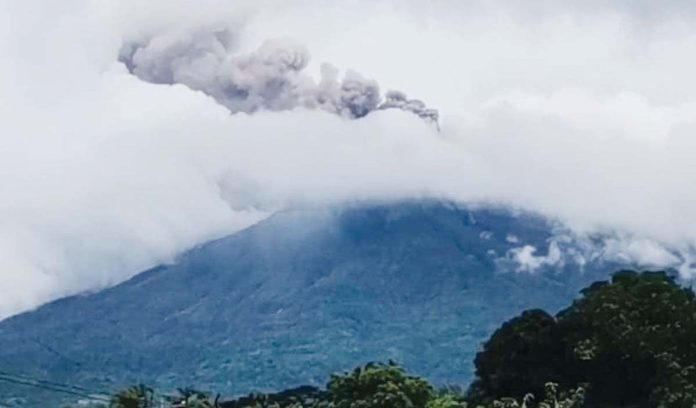
ILOILO – Task Force Kanlaon has urged evacuees displaced by Mount Kanlaon’s recent eruption not to return to their homes yet, citing the continuing danger in the area.
Office of Civil Defense (OCD) Western Visayas director Raul Fernandez, who chairs the taskforce, cautioned residents living within the six-kilometer extended danger zone of the volcano.
“We at the Office of Civil Defense, along with other government agencies like Phivolcs, don’t want you to be in trouble,” Fernandez said.
Kanlaon Volcano, a stratovolcano standing at 2,465 meters above sea level, straddles the provinces of Negros Occidental and Negros Oriental. Known as the highest peak in the Visayas, it is part of the Pacific Ring of Fire and one of the most active volcanoes in the Philippines.
Fernandez pointed out the unpredictability of volcanic activity, warning against complacency.
Kanlaon erupted on December 9, 2024. The Philippine Institute of Volcanology and Seismology (PHIVOLCS) reported that the explosion occurred at 3:03 p.m., releasing a massive ash plume and triggering pyroclastic flows.
Fernandez drew comparisons to the 1991 eruption of Mount Pinatubo, which erupted after 600 years of dormancy, causing widespread destruction.
“There’s always a first time,” he said. “If that happens with Kanlaon, we might become victims,” he said.
Kanlaon has over 30 recorded eruptions since 1819. Its most violent eruption in recent history occurred in August 1996, when a sudden explosion killed three climbers and injured 18 others.
Controlled Access and Gov’t Assistance
To address evacuees’ concerns about their livelihoods, Fernandez said the government is providing support.
Evacuees are allowed to visit their lands to harvest crops from 6 a.m. to 4 p.m., but only with prior permission so authorities can monitor their safety.
“This is for your own safety,” Fernandez stressed, explaining the need to account for anyone who might require evacuation in case of an eruption.
As of January 7, 2025, data from the Department of Social Welfare and Development (DSWD) Region 6 and Region 7 show that 12,226 families, or 46,787 individuals from 26 barangays, have been affected by the eruption. But not all of them evacuated.
Here’s the breakdown of the 6,370 families (or 20,541 individuals) that evacuated by municipality:
* Bago City – 444 families (1,480 persons)
* La Carlota City – 1,545 families (4,924 persons)
* La Castellana – 2,308 families (7,525 persons)
* Pontevedra – one family (2 persons)
* San Carlos City – 68 families (227 persons)
* Canlaon City – 2,004 families (6,383 persons)
Of these, 4,019 families (12,083 individuals) are in 34 evacuation centers, while 2,351 families (7,458 individuals) are staying with relatives or friends.
Over P103-M Assistance Released
A total of P103,648,062.37 in assistance has been distributed to affected residents (evacuees and non-evacuees) by the DSWD (P72,431,297.95), local government units (P13,063,468.53), non-government organizations (P14,661,295.89), and other entities (P3,492,000).
The DSWD Regions 6 and 7 still have P244,379,142.64 worth of standby and prepositioned relief stockpiles, which include P500,000 in standby funds, 201,157 family food packs valued at P142,368,632, and P101,510,509.68 worth of non-food items.
Here’s the breakdown of affected families (evacuees and non-evacuees combined) by municipality:
* Bago City – 845 families (2,834 persons)
* La Carlota City – 1,988 families (6,416 persons)
* La Castellana – 3,783 families (10,853 persons)
* Moises Padilla – four families (36 persons)
* Murcia – 562 families (2,062 persons)
* Pontevedra – 246 families (722 persons)
* San Carlos City – 68 families (227 persons)
* Canlaon City – 4,730 families (23,637 persons)/PN



